Passport-free ‘FaceBoarding’ trial at airports could mean major changes for how you travel
Travellers can keep their passport in their pocket using the facial recognition system

Your support helps us to tell the story
From reproductive rights to climate change to Big Tech, The Independent is on the ground when the story is developing. Whether it's investigating the financials of Elon Musk's pro-Trump PAC or producing our latest documentary, 'The A Word', which shines a light on the American women fighting for reproductive rights, we know how important it is to parse out the facts from the messaging.
At such a critical moment in US history, we need reporters on the ground. Your donation allows us to keep sending journalists to speak to both sides of the story.
The Independent is trusted by Americans across the entire political spectrum. And unlike many other quality news outlets, we choose not to lock Americans out of our reporting and analysis with paywalls. We believe quality journalism should be available to everyone, paid for by those who can afford it.
Your support makes all the difference.Two Italian airports are now trialling ‘FaceBoarding’ at their security checkpoints– facial recognition technology that allows travellers to breeze through the airport without showing their passport or boarding pass.
At Milan Linate Airport and Catania Airport, passengers who are over 18 years old can now board a flight without getting out their travel documents.
To use the service, passengers must first check-in and then register at FaceBoarding desks by scanning their passport or electronic ID card and matching it to a facial scan.
ITA Airways and Scandinavian Airlines passengers are among the first to trial the facial recognition systems to verify their identity while travelling. At some airports, designated lanes for FaceBoarding users means they will have priority at security screening and the boarding gates.
As it stands, travellers on other airlines will have to show their travel documents again before they board the aircraft.
After you have registered at the desk once, from June the FaceBoarding app will allow users to attach the boarding passes of future flights to their scanned identity documents.
The trial is set to last until 31 December 2025 and frequent flyers can choose to register to use FaceBoarding for just one or all of their flights for the duration of the process.
However, don’t rush to ditch your travel documents, you will still need to carry identification – including your passport and boarding pass – through the airport to catch your flight.
Security checkpoints and gates can be accessed as usual by showing a passport and boarding pass by passengers who choose not to register for FaceBoarding.
The new biometric recognition software developed by Thales, a French IT company, and Swiss security group Dormakaba hopes to significantly cut security line wait times and reduce the need for border agents.
From 6 October 2024, biometric border checks will be standard across Europe as part of the EU’s new Entry/Exit System (EES), an automated IT system for registering non-EU travellers.
UK passengers, who do not require a visa to enter the EU, will need to submit fingerprints and facial biometrics before they “cross the external borders of European countries”.
Most European airports, apart from Cyprus and Ireland, and non-EU countries including Iceland, Lichtenstein, Norway and Switzerland in the Schengen Area, will apply the EES system.
Join our commenting forum
Join thought-provoking conversations, follow other Independent readers and see their replies
Comments